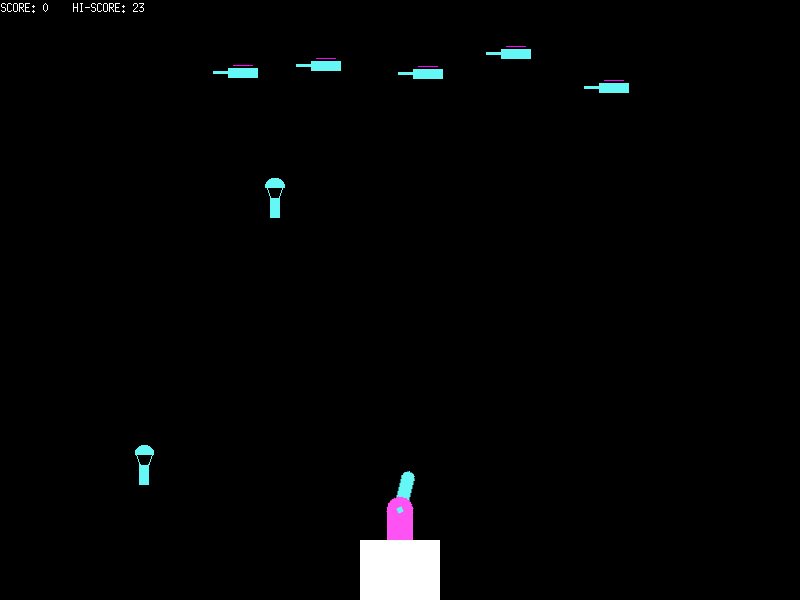
I played
Paratrooper a ton back when I was a kid, and
stumbling across
Ebitengine—a super straightforward 2D game
engine—brought all those memories rushing back. So I went ahead and made my own nostalgia-fueled
version, and it only took a couple of hours to
get a basic prototype going! Now I’ve jotted down a few notes on the simple maths behind ParaGopher for anyone
curious.
Rotating and drawing the turret barrel
When drawing the turret barrel, the code rotates it around its center before positioning it on the screen:
op.GeoM.Translate(-barrelW/2.0, -barrelH/2.0) // Move the barrel origin to its center
op.GeoM.Rotate(g.barrelAngle * math.Pi / 180)
op.GeoM.Translate(centerX, centerY)
Finding the bullet's spawn position (tip of the barrel)
When you press shoot, the game creates a bullet at the tip of the barrel. The code first identifies a local offset in
the barrel’s coordinate system—something like:
localTipX := width / 2 // half of the base width
localTipY := width / 12
Then it rotates these local coordinates by the turret’s angle to get the world position of the tip:
dx := float64(localTipX - width/2)
dy := float64(localTipY - width/2)
rx := float32(dx*math.Cos(angleRadians) - dy*math.Sin(angleRadians))
ry := float32(dx*math.Sin(angleRadians) + dy*math.Cos(angleRadians))
tipX := barrelCircleX + rx
tipY := barrelCircleY + ry
Here
(dx, dy) is the local offset from the pivot. The standard 2D rotation formulae are $$
\left.\begin{array}{l} x' = x\cos(\theta) - y\sin(\theta), \\ y' = x\sin(\theta) + y\cos(\theta), \end{array}\right\}
$$ where $\theta$ is the rotation angle in radians.
Computing bullet's velocity components
Once the bullet's initial position
(tipX, tipY) is known, its velocity
(vx, vy)
depends on the turret's angle and a speed constant:
realAngleRadians := (90.0 - g.barrelAngle) * math.Pi / 180.0
vx := float32(config.BulletSpeed * math.Cos(realAngleRadians))
vy := -float32(config.BulletSpeed * math.Sin(realAngleRadians))
Notice the
(90.0 - barrelAngle) logic. This is because in normal world maths angle $0$ means pointing
along the positive $x$-axis but here it is actually 'straight up', so we're shifting the frame of reference so that
$0$ means
up in the game world. Finally, the screen's $y$-axis is growing downwards, hence the negative sign in
front of the expression for
vy.
Updating bullet's position (basic kinematics)
On every frame, each bullet’s position is updated by adding the velocity:
b.x += b.vx
b.y += b.vy
This is effectively $$ \left.\begin{array}{l} x \leftarrow x + v_x, \\ y \leftarrow y + v_y \end{array}\right\} $$
(which is the simplest form of motion at a constant velocity). If a bullet goes off-screen or hits a target, it’s
removed from the game.
Collision checks
The code for detecting collisions just checks if the two rectangles—one around the bullet, one around the
target—overlap. If they do, the bullet is marked as hitting the target. That’s pretty much the whole idea—after that,
it’s just pressing buttons with your fingers!
 I played
Paratrooper a ton back when I was a kid, and
stumbling across Ebitengine—a super straightforward 2D game
engine—brought all those memories rushing back. So I went ahead and made my own nostalgia-fueled
version, and it only took a couple of hours to
get a basic prototype going! Now I’ve jotted down a few notes on the simple maths behind ParaGopher for anyone
curious.
I played
Paratrooper a ton back when I was a kid, and
stumbling across Ebitengine—a super straightforward 2D game
engine—brought all those memories rushing back. So I went ahead and made my own nostalgia-fueled
version, and it only took a couple of hours to
get a basic prototype going! Now I’ve jotted down a few notes on the simple maths behind ParaGopher for anyone
curious.